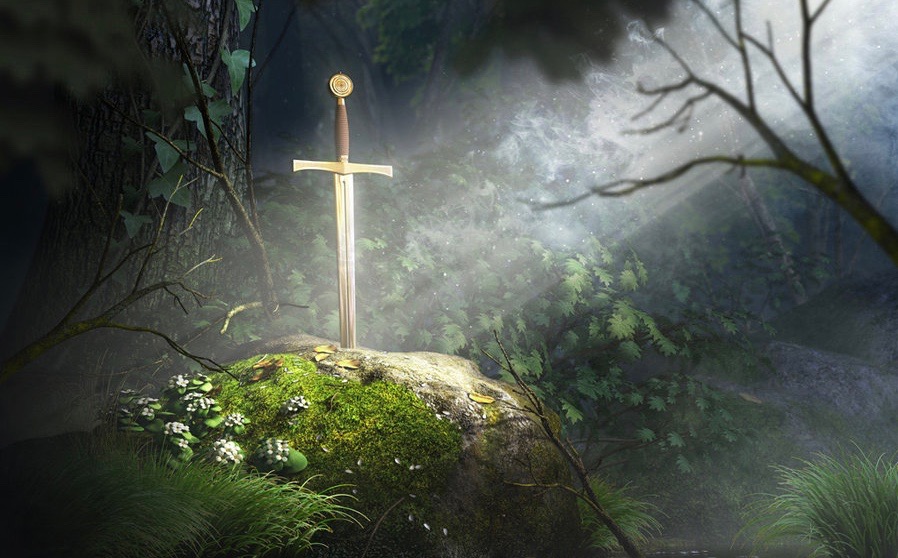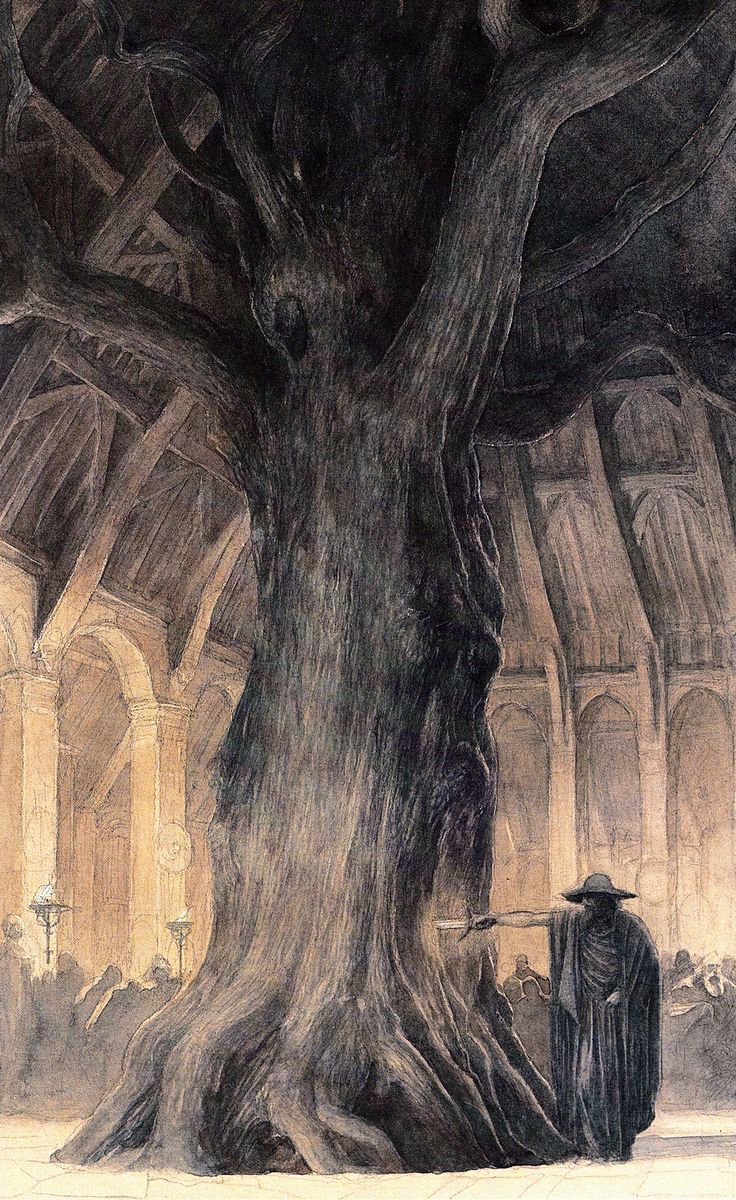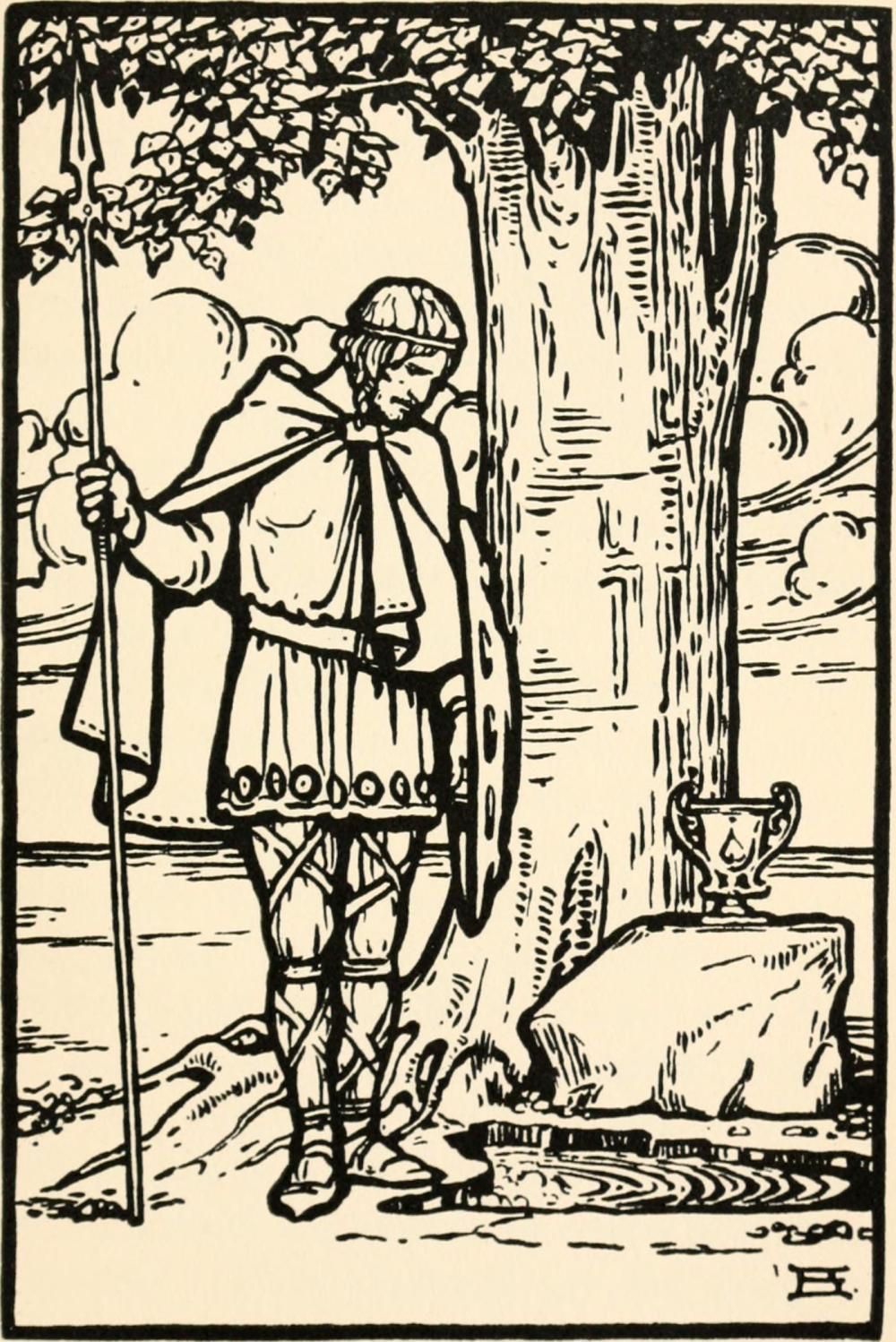At this point my conclusion regarding Arthurian Legend is clear. Yet it is a mistake not to treat the major features of this tale so as to understand just how harmful this myth is to us in nearly all its important aspects, except, of course, as a profoundly illuminating study.
With Arthurian Legend, here at last, the Semitized “pagan” Myth turns men Christian, the agenda becomes explicit. After all the JEM, the Norse myth, the Celtic myth, they are ready now. The Barbarian no longer finds it strange that he is living and dying for a Jewish God. Why would he? This Jewish God is similar to the hanging Odin, “his God.”
Arguably Arthur himself, the Dying and Rising God, the Once and Future King, frequently understood as a clear Christ figure, is Semitic, earthly, vegetative. And to an extent, this is certainly true. Indeed, Arthur is descended of Luther Pendragon and will become known as the Red Dragon of Wales, a serpent, a vine. Again, the color red is important here.
One story describes Merlin dreaming of a red dragon fighting a white dragon, the first representing Arthur and his forces and the second representing Mordred and his. Here we see vividly, explicitly, the Caducean. The red dragon, the Christianized, the admixed, filled with the Semitic blood wine of Christ, must destroy the evil “pagan”, “white dragon.” That both are Dragons is itself revealing. Again: the Caducean. The white Dragon is clearly not “pagan” in any meaningful manner. To wit, he clearly is not Apollonian.

And, indeed, the harmful Norse Ragnarok is imported into this tale as well, madly, hatefully, sinisterly, cruelly, shamelessly, under the rubric of Christianity. The cataclysm here is called the battle of Cammalan. As with Ragnarok, everyone dies. Yet as with Balder, it is promised Arthur will return. This motif people dare call Aryan. Here again we find the seasonal. That which makes men passive, ruled: “one day, things will be good again. We must simply be patient.”
If one guesses that the world wars we have suffered do not owe their genesis to the Ragnarok described here, described in Norse myth and most deeply and importantly in Revelation, he must guess again. Realize also now the astonishing impact of REM. During the World Wars, the Anglo-Sphere fancied themselves Arthur versus Mordred and Germany accepted as its fate that it was tragic Siegfried. Both understood, everyone must die.
This anti-Aryan war propaganda is over a thousand years old. Likewise this is ultimately why National Socialism cannot be understood as entirely “pagan.” Deep in their bones, well before it was too late, they accepted “Revelation” as much as any Christian. All this, we will change.
In Arthurian legend, the humor here is deep and dark. The crucifix itself appears in the form of a sword in a stone to be wielded to kill pagans, eventually Arthur’s own scion. We know that knights, mortally stricken in battle, prayed to the cross hilt of their swords. Of course, a simple glance at the sword and the stone proves it a crucifix.

Mythographers guess that the sword in the stone is a reference to metallurgy. The sword is being drawn from the stone as metals are drawn from the earth. And to be sure, we know Vulcan is nearby. Yet the reader, now with eyes, already sees the deeper symbolism. The sword, the crucifix, the symbol of admixing, by which Arthur unites his kingdom, comes from the stone of Jewry. Here we find Peter the Rock, Christ the Rock and so forth. The stone as this study explicates is an abiding symbol of the Jewish God.
Indeed, Peter and Christ “the fishers of men” appear in the grail-bearing Fisher King. There as well we find Vulcan. The Fisher King is understood as lame, just like Vulcan, still nursing that immortal wound of his expulsion, still “never forgetting.” Well, he’s had quite a bit more than his revenge selling Aryans “The Grail.”
But, of course, the whole metaphor of the Grail Quest contains the darkest and most hateful humor of the tale. Here men, when the kingdom has fallen into a dark age, are literally “chasing a drink” as the solution of their problem! We remember that the Grail is a lost item they are seeking to recover. Hence, here, as everywhere, with Christianity, with Liberalism, with Multiculturalism, more of the problem ostensibly solves the problem. “Hair of the Dog” alcoholics call it.

Of course, the other level of the Grail Quest is that they are chasing “Christ’s blood,” Semitic blood, which, indeed, we do find through degeneracy, alcoholism and vice. Just ask the thirsty British lass with her Muslim boyfriend. We know in our hearts that the mead soaked halls of Valhalla and the thirsty Grail Quest are responsible for both the fratricides of Europe, its appalling alcoholism and its dysgenic breeding. But, of course, this alcoholism is connected to these wars. When Arthur finally drinks the Grail himself, intoxicated by its “magical spirit,” he makes a characteristically sober decision. He becomes the drunk Viking Berserker and goes to war against his own son.
Yes, Mordred is the product of an incestuous union. But understand clearly the wizard’s trick here. The mythological Arthur and Morgana are no more brother and sister than Juno and Jupiter or Apollo and Diana. They are racial brother and sisters. And here we begin to understand Arthur as Aryan, as Saul beguiled by Merlin whom is Samuel. This charge of incest should sound very familiar to us. In America, when it was perceived that Southerners were opposed to miscegenation, immediately they were characterized as inbred. Recently, the Covington Catholic high school boys were called “incest kids” by their Black Hebrew Israelite detractors.
Indeed, why make this obscure and infrequent pattern of incest the great kingdom-ending danger? Why not make its opposite the danger, that which actually does end kingdoms? To wit, the admixing with foreign and non-Aryan elements. The Chimera in Greek myth is the perfect symbol in this regard. The beast itself is understood as having been derived from the lion whom lived on the top of a mountain, a goat whom lived in the middle and a serpent whom lived at the base. Clearly we see described here, the ruling Aryan, his goatish flock, and the serpentine Semite, freakishly conjoined. In Art and Religion, this, the Chimera, should be understood as the greatest enemy of the good.
Etymologies that link Merlin to Mercury I find the most compelling. Regardless, clearly Merlin is derived from Odin, the trickster God, whom the Romans identified with their Mercury, the God of Deceivers. Odin’s placing the sword Garmr in Branstokkr, referenced with Merlin’s connection to the sword and the stone, shows this clearly. Here as well, we find, again, the personification of Christian Clergy, the real “wizards” of the medieval period particularly as viewed through pre-Christian, barbarian eyes.

Merlin’s struggles with Morgana might be understood as well as depicting concerns around priestly celibacy. Hence we see an esoteric art developed by “Christians” or Jews whom understand themselves to be the very forces Interpretatio Romana would identify them as. This esoteric “confession”—a “gansta’s” moralizing wink and nod to fellow Jewish Esotericists—is a common phenomenon in JEM.
And, of course, we have Lancelot, the lover from the south, who cuckolds Arthur. Yes, his name, derived from the Spanish lanzo is, obviously, a sexual innuendo as likely was understood by smirking “adults” when it first emerged in the tales. Certainly he is a Semitic, phallic God. As this study explicates, in contemporary JEM, phallic references, particularly in names, are Jewish identifiers.
The figure Lancelot himself is derived from the Celtic figure of Diarmuid whom cuckolded Arthur’s Celtic precedent named Finn MaCool. Killed by a boar, he is clearly himself a reference to Adonis whom was likewise killed by a boar. Here women, joyfully, are given a more explicit version of the Mary and Jesus romance, where adultery, even, esoterically, racial adultery is made the very quintessence and ideal of romance and “courtly love.” How could men have considered this salubrious? In the end, as well, Lancelot becomes a kind of David vis-à-vis the Saul that is Arthur, even if cataclysm greets them all.

So Arthur is the King we are given? The model of European aristocracies? Saul the cuckold, the Benjamin who lives to provide for Judah? He whose great answer is cataclysm in the name and service of a Jewish God? Indeed, naturally Chthonic forces would desire the fool and tool Arthur as “the Once and Future King.”
Indeed, as if we needed another reason to believe the aristocracies of Europe were utterly useless, bred for exploitation and defeat from day one. That does not mean they should not begin to rapidly curry favor with that which comes, that which will save the Aryan race. Indeed, may the very best part of them, as with the rest of us, pass on. Let the rest disappear.
As it concerns the Englishman, who now feels compelled to scurry to Beowulf to prove his rich, “snowflake,” distinctiveness from the Aryan body, we say, Apollo was not killed by the Dragon nor overcome by his fumes. Indeed, in contrast, the nation we aspire to is immortal, so are its people, and so is its God. Churchill is dead and so is his brother-hatred.
Below is an episode of “The Apollonian Transmission” discussing Arthurian Legend:
https://www.bitchute.com/video/l4aU2FvQ8WAs/
Well said. Seasons make one passive. To eternally rule, we must eternally exert our force. The struggle is forever.
LikeLike
What does the number 12 mean symbologically?
LikeLike
I have an entire section on numerology that I will be releasing. I speculate 12 is primarily a reference to the 12 Zodiacs. Symbolically I argue it is related to the “world” or everything under the firmament, particularly a nocturnal or Semitic firmament. Hence the 12 tribes, the 12 Apostles and 12 Arthurian Knights, for example, are given a similar significance. But wait for the numerology section so I don’t have to rewrite all these ideas. LOL.
LikeLike
Do you posit that the pre Christian folk tales and myth (if anything we have left actually are) have been also corrupted by these “wandering merchants” pre Christianity? Or are they still genuine?
Or is it simply the case that everything written that remains (barring things like text on Roman triumphs etc ) have all been reinterpreted through this Judaic lens?
LikeLike
Could you please reveal the symbolism behind Conan the Barbarian (1982)? I love that movie since childhood but it has always puzzled me, just like Excalibur (1981). It’s like with Arthur and Merlin, I love these characters and story, but at the same time you feel there’s something more to it. Something you don’t resonate with but cannot precisely point the finger at it. The more I think about Hollywood movies and even older Christian stories, the more it all reminds me of cookies with an undertaste from “Rosemary’s Baby”.
LikeLiked by 1 person
Good Idea. I’ll do that soon with article as well. I’ve one that probably requires a little revision after all my research.
LikeLiked by 1 person
“Beastmaster” has awesome symbolism
LikeLike